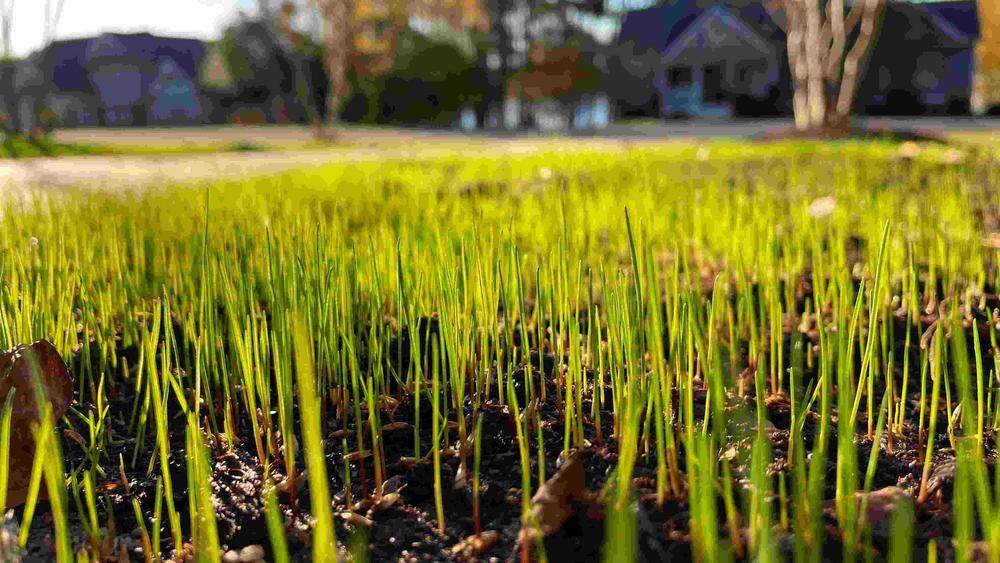At Lawn Synergy, “can you put starter fertilizer on existing grass?” is a common question among lawn enthusiasts looking to keep their grass lush and green.
From our experience, it's important to understand when and how to use starter fertilizer effectively. If you're pondering this question too, well, you're in luck.
In this article, we'll answer this question by delving into when you should apply starter fertilizer, when you shouldn't, and some general tips and advice.
So, if you're ready to broaden your horizons and transform your lawn, continue reading.
What this article covers:- Can I Use a Starter Fertilizer on Existing Grass?
- When to Apply Starter Fertilizer
- When Shouldn't You Use Starter Fertilizer on Existing Grass?
Can I Use a Starter Fertilizer on Existing Grass?
Our findings show that starter fertilizer is specifically formulated for new lawns. It has higher phosphorus content to promote root development, which is crucial for seedlings and young grass.
While, yes, it can be used on existing grass, it's not always the best choice. This is because established lawns typically require more nitrogen and less phosphorus to thrive.
Using starter fertilizer on mature grass can lead to nutrient imbalances and potentially harm the lawn's health.
However, for those times when you need a boost for your lawn, or if your soil test results show low nitrogen, phosphorus, and potassium levels, Starter Fertilizer is a great choice because it will give your lawn a boost of all these 3 main macronutrients all at once.
Our Starter Fertilizer 15-20-10 Plus Iron is designed to feed essential nutrients to your lawn, ensuring that your lawn is transformed into a verdant oasis.
It includes slow-release nitrogen and 3.5% Iron and Ammonium Sulfate to bring out that dark green color you're aiming for.
This blend not only supports initial root development but also enhances the overall health and appearance of your grass, making it an excellent choice for those looking to give their lawn a strong start or a mid-season boost.
Our esteemed lawn fertilizer collection is perfect for all lawn enthusiasts and DIY professionals.

When to Apply Starter Fertilizer:
Let's look at when to apply starter fertilizer as well as general tips to maintain your lawn:
Fertilize Before Seeding/Laying Sod
When seeding a new lawn or laying sod, using a starter fertilizer is ideal. This helps the new grass establish strong roots by providing essential nutrients during its initial growth phase.
Once the grass is established, switch to a regular lawn fertilizer to maintain its growth and health. Regular fertilizers typically contain balanced nutrients suitable for maintaining an already established lawn.
We recommend the Almighty 20-0-10 Lawn Fertilizer, as this award-winning product is high in nitrogen but slow-release, ensuring long term growth.
Growing Grass Seedlings
When growing grass seedlings, applying starter fertilizer is crucial for their successful establishment.
By using starter fertilizer, you provide the necessary nutrients that help grass seedlings establish strong and healthy roots, ensuring they can access water and nutrients effectively as they grow.
Similar to above, once the seedlings are well-rooted and start to mature, transition to a regular lawn fertilizer to maintain their growth and overall lawn health.
Fertilize Every 4-6 Weeks
Maintaining a regular fertilization schedule is crucial for a healthy lawn. Our findings show that fertilizing every 4-6 weeks keeps your lawn healthy and lush.
Regular applications ensure your lawn receives a consistent supply of nutrients necessary for optimal growth.
Make sure to adjust the type of fertilizer according to the season and grass type to meet your lawn's specific needs.
For instance, during the growing season, use a fertilizer with higher nitrogen content to promote vigorous growth, while in the fall, a fertilizer with more potassium can help prepare the lawn for winter.
This approach helps maintain the overall health and appearance of your lawn throughout the year.

When Shouldn't You Use Starter Fertilizer on Existing Grass?
Starter fertilizer is not recommended for established lawns during periods of dormancy or extreme weather. If you're wondering “Is it ok to fertilize lawn in hot weather?” Generally, no unless it is watered after application.
High heat can stress your lawn, making it less effective to absorb nutrients. During dormancy, grass is not actively growing, so it won't benefit from the nutrients provided by starter fertilizer. We recommend our Emerald 10-0-20 Lawn Fertilizer. It is a fantastic stress blend fertilizer designed to slowly release nitrogen and provide potassium to the lawn preventing stress and increasing disease resistance. It also contains 10% iron for darker green color. It’s our number 1 selling lawn fertilizer.
Additionally, applying fertilizer during extreme weather, whether it's too hot or too cold, can cause stress to the grass and reduce its ability to uptake nutrients efficiently.
It is essential to use fertilizers that are specifically designed for the current condition and growth stage of your lawn to avoid potential damage and ensure optimal growth.
Curious about lawn fertilizers? Why not check out our articles “Is lawn fertilizer toxic?”, “Do I need to fertilize my lawn?” and “Does lawn fertilizer go bad?” for more information.
Conclusion
A beautiful lawn requires the right fertilizer applied at the right time, ensuring it gets the nutrients needed for optimal growth.
From our experience, while asking "can you put starter fertilizer on existing grass" is a valid concern, it's often more beneficial to use a fertilizer specifically suited for established lawns.
For the best lawn care advice and top-quality products, visit Lawn Synergy. By following these expert guidelines, your lawn will flourish throughout the seasons, maintaining its lush, green appearance.
Trust Lawn Synergy to help you achieve the perfect lawn. Happy gardening from all of us at Lawn Synergy!
If you want to learn more, why not check out these articles below:
- Lawn Food vs Fertilizer
- Liquid Vs Granular Lawn Fertilizer
- Can You Fertilize Dormant Grass
- Does Grass Fertilizer Kill Weeds
- Best Weed and Feed for Bermuda Grass
- Best Fertilizer for Yellow Grass
- Best Fertilizer for Bahia Grass
- Best Fertilizer for Tall Fescue Grass
- Best Weed and Feed for St. Augustine Grass
- Best Fertilizer for Centipede Grass in South Carolina
- Best Grass Seed Fertilizer
- Best New Lawn Fertilizer
- Best Organic Fertilizer for Lawn
- Best Weed and Feed for Lawns
- Best Lawn Fertilizer for Texas

